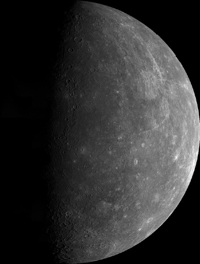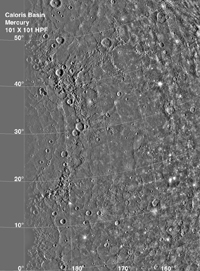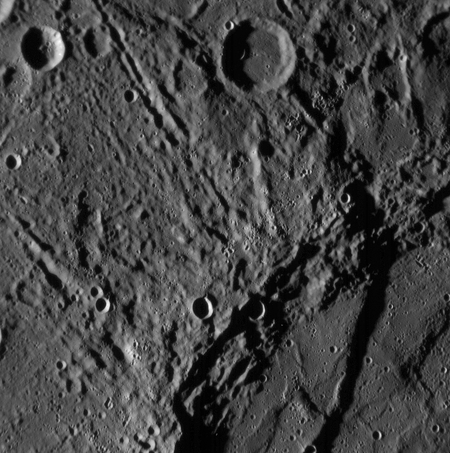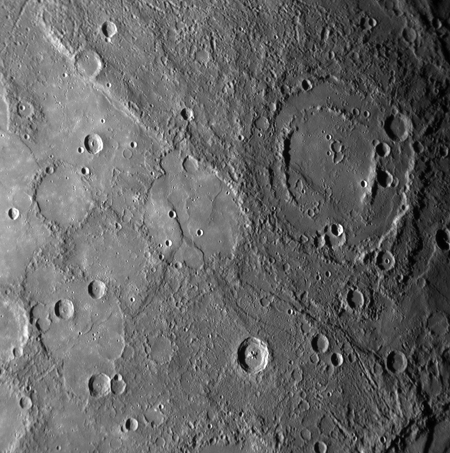On February 1, 2008, MESSENGER performed its first flyby of the planet Mercury. Final orbital insertion is scheduled for March 18, 2011 but another flyby will occur before then - on October 6, 2008. Scroll to the bottom to learn more.
With limited visits by space probes, we know very
little of the planet Mercury. Mercury does resemble
a familiar body - the
Moon - but is larger and more
dense than the
Moon. The
density of Mercury is
actually 60% more dense than the
Moon, which
indicates a larger iron core.
The evolution is
similar to that of the
Moon in that differentiation
occurred (iron at the center), extensive cratering
is present, and basin flooding like the maria on the
Moon is present. One feature that is present on
Mercury and not the
Moon is the presence of what
looks like small fractures scattered over the
surface. The second image below shows these areas.
It is thought that this is a result of a rapidly
cooling of the planet early on resulting in some
shrinkage.
For eclipse information, visit the eclipse page.
Mercury - A Quick Summary: (More information can be found on the Mercury Fact Sheet)
 |
Average Distance from Sun: |
5.79 x 107 km |
| Eccentricity of Orbit: |
0.206 |
| Average Orbital Speed: |
47.9 km/s |
| Orbital Period: |
87.969 days |
| Rotational Period: |
58.646 days |
| Inclination of Equator to
Orbit |
0.5° |
| Diameter: |
4,880 km |
| Mass: |
3.302 x 1023 kg |
 |
Average Density: |
5430 kg/m3 |
| Escape Speed: |
4.3 km/s |
| Albedo: |
0.12 |
| Maximum Surface
Temperature: |
350° C |
 |
| Minimum Surface
Temperature: |
-170° C |
| Average Surface
Temperature: |
N/A |
| Atmospheric
Composition |
Trace Helium |
What is surprising is that Mercury does have a
trace atmosphere. Mostly helium, this atmosphere is
easily escaped into space and does not assist in
controlling the
temperature (in fact its so minor
its almost not worth mentioning). Because of the
lack of a substantial atmosphere, the solar
radiation heats the
Sun side of the planet to
intense levels while the dark side can reach to well
below freezing. Of all the feature on Mercury, the
most prominent is the Caloris Basin, seen in the
last image above. This is actually an ancient impact
crater that spans 1300 km in diameter - one of the
largest in the Solar System. material from the
impact extends an additional 600 to 800 km.
The MESSENGER mission
has set out to change what we know about this small, rocky planet.
The first flyby of this probe already revealed a previously unseen side of Mercury - already the probe is performing as promised.

This unseen side shows just how dramatic the surface has evolved. In fact, the MESSENGER probe is designed to teach us more about how terrestrial planets (planets without large, gaseous atmospheres) evolved.
There are six questions to be answered by the MESSENGER probe:
- Why is Mercury so dense? The core is metal-rich and contributes to 60% of the planet's total mass.
- What is the geologic history? Only 45% of Mercury has been imaged. MESSENGER will image the entire planet.
- What is the nature of Mercury's magnetic field? Like Earth and Mars, Mercury has a global magnetic field. Venus does not.
- What is the structure of Mercury's core? It's density along with gravitational field measurements will help determine this.
- What are the unusual materials at Mercury's poles? Radar images from Earth speculate that ice may be present within some of the crater walls not exposed to the Sun.
- What volatiles are important at Mercury? The composition of Mercury's thin crust will be determined.
These answers will help us better understand terrestrial planetary formation. One thing we have learned with the current data and that is Mercury is shrinking! The cause is simple, the iron core is continuing to cool. The result of the cooling are the cracks we see on the surface.
And now, a few more pictures care of MESSENGER:

Close-Up of the previously unseen side
And here are some hints at the geologic history:

Back to Top |

